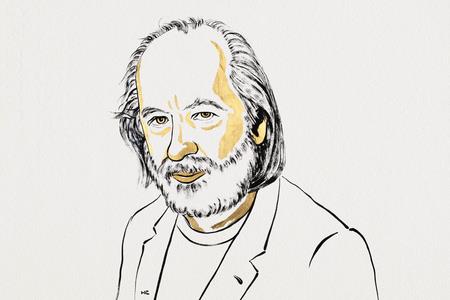
Hungary's Krasznahorkai, Whose Pensive Oeuvre Straddles East And West, Conferred Literature Nobel
Announcing the award, the Swedish Academy said Krasznahorkai was chosen "for his compelling and visionary oeuvre that, in the midst of apocalyptic terror, reaffirms the power of art".
The second Hungarian to win the top global literary award after Imre Kertesz in 2002, Krasznahorkai, 71, is also the first from his country to win the Man Booker International Prize in 2015.
Let's take a brief look at some of his work, particularly his novels.
The author, whose oeuvre straddles novels, novellas, short stories, other writings, and screenplays, is not an easy read, describing his own work as "reality examined to the point of madness".
And then stylistically, his work is marked by a distinctively dense style, where sentences go on for pages and pages, paragraphs are clunky and unbroken, the narrative voice and focus suddenly change from character to character, sometimes in the same sentence, time is fluid, and the story's pace, according to one critic, moves at the same speed as social change.
Krasznahorkai debuted with "Satantango" (Hungarian, 1985 English translation "Satan's Tango", 2012), which is postmodernist and multi-perspective in nature, and structured like the tango, with half a dozen steps forward alternating with the same number backwards, and has chapter titles like "We Are Resurrected", "The Distance, As Seen", and "The Distance, as Approached from the Other Side".
Resembling Gogol's "The Government Inspector", it is set in an unnamed decrepit and isolated Hungarian village, though being near a town (also unnamed), where a con man comes and poses as a saviour. He acquires full influence over the inhabitants, takes away all their hard-earned savings, persuades them to move to another village, but brings them to the town and disperses them around the country.
Brought to the screen by acclaimed Hungarian filmmaker Bela Tarr in 1994, the film was seven hours long!
Krasznahorkai's second work, "Az ellenallas melankoliaja" (1989, English translation "The Melancholy of Resistance", 2000) was a political allegory with apocalyptic atmosphere, mirroring the political and social upheaval sweeping through then Communist-ruled Central and East Europe. Set in yet another unnamed, but restless town, it has a mysterious circus, whose sole exhibit is a dead whale, contributing to the disquiet, further fuelled by the arrival of a trainload of rabble rousers, and a housewife taking control to fight them off.
How can this all be interpreted, particularly in the light of contemporary events, the author leaves to the readers to think.
The author moved out of Central Europe with "Haboru es haboru (1999, English translation "War and War", 2006) about a Hungarian man, obsessed with a mysterious manuscript, and deciding to go to New York City to write it down and post on the Internet, and then further with "Rombolas es banat az Eg alatt" (2004).
Coming out in English as "Destruction and Sorrow Beneath the Heavens" (2016), it tells of a Hungarian man travelling to China to find out about traditional Chinese culture and its understanding and reception by the present-day society there.
Krasznahorkai's next work was "Seiobo jart odalent" (2008, English translation "Seiobo There Below", 2013), spanning time and place, from Japan to ancient Persia to Renaissance Italy and present-day Europe, in its accounts of real-life and fictional artists. Interestingly, its 17 chapters are numbered according to the Fibonacci sequence, and thus begin with 1 and end with 2,584.
The subsequent, "Baro Wenckheim hazater" (2016, English translation Baron Wenckheim's Homecoming, 2019), which returns to the author's home country but is yet another perplexing tale on an elderly and eccentric aristocrat's homecoming, the people's expectations, murder, and local politics, was considered by the author to be his best.
Explaining his contention, Krasznahorkai, in an interview, said that he had "always wanted to write just one book".
"I wasn't satisfied with the first, and that's why I wrote the second. I wasn't satisfied with the second, so I wrote the third, and so on. Now, with Baron, I can close this story. With this novel, I can prove that I really wrote just one book in my life," he told the Paris Review.
However, Krasznahorkai has done at least two more novels, both yet to be translated from Hungarian, and two novellas since then, apart from his non-fiction writings.
(Vikas Datta can be contacted at ...)

Legal Disclaimer:
MENAFN provides the
information “as is” without warranty of any kind. We do not accept
any responsibility or liability for the accuracy, content, images,
videos, licenses, completeness, legality, or reliability of the information
contained in this article. If you have any complaints or copyright
issues related to this article, kindly contact the provider above.
Most popular stories
Market Research

- Moonx: The Leading Crypto Trading Platform With X1000 Leverage And Unlimited Meme Coin Access
- T-REX Launches Intelligence Layer To Fix Web3's Value Distribution Problem
- Yield Basis Nears Mainnet Launch As Curve DAO Votes On Crvusd Proposal
- Bydfi Highlights 'BUIDL' Ethos During Newcastle United Match Against Arsenal
- Alt.Town Introduces $TOWN Token Utility Across Platform Services And Launches Valuefi Deposit Event
- Dexari Unveils $1M Cash Prize Trading Competition


















Comments
No comment